Diagnostic Performance of Artificial Intelligence in Chest Radiographs Referred from the Emergency Department
Abstract
1. Introduction
- ▪
- To evaluate the sensitivity and specificity of AI software and a radiology resident in the evaluation of chest X-ray examinations referred from the ED, in comparison with a senior radiologist, regarded as the gold standard (GS).
- ▪
- To assess the concordance rate between AI and the resident.
- ▪
- To describe the frequency of doubtful cases in each category and how many of them are considered positive by the GS.
- ▪
- To evaluate other variables that AI is not trained to detect, in order to analyze its weaknesses and potential areas for improvement in diagnosis.
2. Materials and Methods
- The diagnostic performance of AI and the resident against the GS: evaluating sensitivity (Se), specificity (Sp), predictive values, area under the curve (AUC), and 95% confidence intervals (CI).
- The frequency of doubtful results: determining the occurrence of doubtful findings and their classification by the GS.
- The frequency of other variables that AI did not detect but could have an impact on diagnosis: mediastinal abnormalities, surgical material, and other pulmonary findings.
- Qualitative variables were described in absolute (n) and relative (%) frequencies.
- Continuous variables as means (±standard deviation) or medians (interquartile range).
- For AI validation, contingency tables were used to calculate sensitivity, specificity, predictive values, area under the curve (AUC) (compared with GS), and 95% confidence intervals (CI).
- The Kappa coefficient was used to evaluate interobserver agreement between the resident and AI.
- All statistical analyses were calculated using SPSS statistical software, Version 25.0 (IBM).
3. Results
3.1. Statistical Results
3.1.1. Demographics
3.1.2. Prevalence
3.1.3. Diagnostic Performance
Fracture
Pneumothorax
Pulmonary Nodule
Pulmonary Opacity
Pleural Effusion
3.1.4. Resident
3.1.5. Other Variables
3.1.6. Concordance Rate for AI and the Resident
4. Discussion
- -
- Remote work by radiologists: in contexts where radiologists work from locations separate from imaging facilities, AI can provide crucial diagnostic support for remote interpretation.
- -
- -
- High demand for radiological examinations: with the increasing volume of radiological examinations, AI can help manage and streamline the workload by providing rapid preliminary assessments. This not only helps in reducing significantly the burden on radiologists but also speeds up the diagnostic process.
- -
- Direct evaluation by emergency physicians: in many EDs, X-rays are evaluated directly by treating emergency physicians (who rely on personal experience and basic skills) rather than by radiologists. Various studies have reported discrepancies between radiograph interpretations in the emergency department and those made by radiologists [28]. AI has the potential to enhance diagnostic accuracy and efficiency in these contexts, assisting emergency physicians in making informed clinical decisions.
- -
- AI can serve as a valuable resource for radiologists in training, particularly when senior radiologists are not available, offering diagnostic support and enhancing learning opportunities.
Limitations
- We evaluated only a small sample of adult patients over a brief period.
- The added value of AI in radiology should be assessed not only through statistical parameters like sensitivity and specificity, but also by evaluating its impact on workflow efficiency, patient management improvements, and enhancing radiologists’ work–life balance.
- Focusing on five specific abnormalities rather than analyzing all possible abnormalities on a chest X-ray, while also disregarding the patient’s clinical information, does not accurately reflect daily clinical practice.
- The low prevalence of pneumothorax and pulmonary nodules resulted in broad confidence intervals (and, consequently, reduced statistical precision), which may affect Kappa values. Other studies, such as Bennani et al., addressed this issue by having a senior thoracic radiologist select radiographs to create a balanced dataset that included both normal and abnormal images of varying complexity [26].
- The exclusion of doubtful cases in the statistical analysis led to worse results. However, it is still useful in clinical practice, since it alerts that the reliability is lower.
- We independently compared the diagnostic accuracy of AI software with that of manual reading. However, several factors seem to limit the ability of AI-based systems to diagnose pathologies in radiology without human involvement. A more accurate reflection of the clinical setting might be achieved through an observer test, where the algorithm is used as a second or concurrent reader alongside radiologists, considering the impact of human–machine interaction and final human decision making.
- Finally, the concordance of AI was evaluated with only one radiologist resident, which may limit the generalizability of the findings.
5. Conclusions
Author Contributions
Funding
Institutional Review Board Statement
Informed Consent Statement
Data Availability Statement
Conflicts of Interest
References
- Hovda, T.; Larsen, M.; Romundstad, L.; Sahlberg, K.K.; Hofvind, S. Breast cancer missed at screening; hindsight or mistakes? Eur. J. Radiol. 2023, 165, 110913. [Google Scholar] [CrossRef] [PubMed]
- Lauritzen, A.D.; Lillholm, M.; Lynge, E.; Nielsen, M.; Karssemeijer, N.; Vejborg, I. Early Indicators of the Impact of Using AI in Mammography Screening for Breast Cancer. Radiology 2024, 311, e232479. [Google Scholar] [CrossRef]
- Peters, S.; Kellermann, G.; Watkinson, J.; Gärtner, F.; Huhndorf, M.; Stürner, K.; Jansen, O.; Larsen, N. AI supported detection of cerebral multiple sclerosis lesions decreases radiologic reporting times. Eur. J. Radiol. 2024, 178, 111638. [Google Scholar] [CrossRef] [PubMed]
- Yao, Z.; Wang, H.; Yan, W.; Wang, Z.; Zhang, W.; Wang, Z.; Zhang, G. Artificial intelligence-based diagnosis of Alzheimer’s disease with brain MRI images. Eur. J. Radiol. 2023, 165, 110934. [Google Scholar] [CrossRef] [PubMed]
- Wang, D.; Jin, R.; Shieh, C.C.; Ng, A.Y.; Pham, H.; Dugal, T.; Barnett, M.; Winoto, L.; Wang, C.; Barnett, Y. Real world validation of an AI-based CT hemorrhage detection tool. Front. Neurol. 2023, 14, 1177723. [Google Scholar] [CrossRef]
- Mair, G.; White, P.; Bath, P.M.; Muir, K.; Martin, C.; Dye, D.; Chappell, F.; von Kummer, R.; Macleod, M.; Sprigg, N.; et al. Accuracy of artificial intelligence software for CT angiography in stroke. Ann. Clin. Transl. Neurol. 2023, 10, 1072–1082. [Google Scholar] [CrossRef]
- Canoni-Meynet, L.; Verdot, P.; Danner, A.; Calame, P.; Aubry, S. Added value of an artificial intelligence solution for fracture detection in the radiologist’s daily trauma emergencies workflow. Diagn. Interv. Imaging 2022, 103, 594–600. [Google Scholar] [CrossRef]
- Kuo, R.Y.; Harrison, C.; Curran, T.A.; Jones, B.; Freethy, A.; Cussons, D.; Stewart, M.; Collins, G.S.; Furniss, D. Artificial Intelligence in Fracture Detection: A Systematic Review and Meta-Analysis. Radiology 2022, 304, 50–62. [Google Scholar] [CrossRef]
- Duron, L.; Ducarouge, A.; Gillibert, A.; Lainé, J.; Allouche, C.; Cherel, N.; Zhang, Z.; Nitche, N.; Lacave, E.; Pourchot, A.; et al. Assessment of an AI Aid in Detection of Adult Appendicular Skeletal Fractures by Emergency Physicians and Radiologists: A Multicenter Cross-sectional Diagnostic Study. Radiology 2021, 300, 120–129. [Google Scholar] [CrossRef]
- Hayashi, D.; Kompel, A.J.; Ventre, J.; Ducarouge, A.; Nguyen, T.; Regnard, N.E.; Guermazi, A. Automated detection of acute appendicular skeletal fractures in pediatric patients using deep learning. Skelet. Radiol. 2022, 51, 2129–2139. [Google Scholar] [CrossRef]
- Siouras, A.; Moustakidis, S.; Giannakidis, A.; Chalatsis, G.; Liampas, I.; Vlychou, M.; Hantes, M.; Tasoulis, S.; Tsaopoulos, D. Knee Injury Detection Using Deep Learning on MRI Studies: A Systematic Review. Diagnostics 2022, 12, 537. [Google Scholar] [CrossRef] [PubMed]
- Fritz, B.; Fritz, J. Artificial intelligence for MRI diagnosis of joints: A scoping review of the current state-of-the-art of deep learning-based approaches. Skelet. Radiol. 2022, 51, 315–329. [Google Scholar] [CrossRef] [PubMed]
- de Margerie-Mellon, C.; Chassagnon, G. Artificial intelligence: A critical review of applications for lung nodule and lung cancer. Diagn. Interv. Imaging 2023, 104, 11–17. [Google Scholar] [CrossRef] [PubMed]
- Irmici, G.; Cè, M.; Caloro, E.; Khenkina, N.; Della Pepa, G.; Ascenti, V.; Martinenghi, C.; Papa, S.; Oliva, G.; Cellina, M. Chest X-ray in Emergency Radiology: What Artificial Intelligence Applications Are Available? Diagnostics 2023, 13, 216. [Google Scholar] [CrossRef]
- Li, D.; Pehrson, L.M.; Lauridsen, C.A.; Tøttrup, L.; Fraccaro, M.; Elliott, D.; Zając, H.D.; Darkner, S.; Carlsen, J.F.; Nielsen, M.B. The Added Effect of Artificial Intelligence on Physicians’ Performance in Detecting Thoracic Pathologies on CT and Chest X-ray: A Systematic Review. Diagnostics 2021, 11, 2206. [Google Scholar] [CrossRef]
- Kim, H.; Kang, S.W.; Kim, J.H.; Nagar, H.; Sabuncu, M.; Margolis, D.J.; Kim, C.K. The role of AI in prostate MRI quality and interpretation: Opportunities and challenges. Eur. J. Radiol. 2023, 165, 110887. [Google Scholar] [CrossRef]
- Thijssen, L.C.P.; de Rooij, M.; Barentsz, J.O.; Huisman, H.J. Radiomics based automated quality assessment for T2W prostate MR images. Eur. J. Radiol. 2023, 165, 110928. [Google Scholar] [CrossRef]
- Alis, D.; Kartal, M.S.; Seker, M.E.; Guroz, B.; Basar, Y.; Arslan, A.; Sirolu, S.; Kurtcan, S.; Denizoglu, N.; Tuzun, U.; et al. Deep learning for assessing image quality in bi-parametric prostate MRI: A feasibility study. Eur. J. Radiol. 2023, 165, 110924. [Google Scholar] [CrossRef]
- Soyer, P.; Fishman, E.K.; Rowe, S.P.; Patlas, M.N.; Chassagnon, G. Does artificial intelligence surpass the radiologist? Diagn. Interv. Imaging 2022, 103, 445–447. [Google Scholar] [CrossRef]
- Parikh, R.B.; Obermeyer, Z.; Navathe, A.S. Regulation of predictive analytics in medicine. Science 2019, 363, 810–812. [Google Scholar] [CrossRef]
- Kumar, R.; Indrayan, A. Kumar-2011-Receiver operating characteristic 1. Indian Pediatr. 2011, 48, 277–287. [Google Scholar] [CrossRef] [PubMed]
- Polo, T.C.F.; Miot, H.A. Use of roc curves in clinical and experimental studies. J. Vasc. Bras. 2020, 19, e20200186. [Google Scholar] [CrossRef] [PubMed]
- Mandrekar, J.N. Receiver Operating Characteristic Curve in Diagnostic Test Assessment. J. Thorac. Oncol. 2010, 5, 1315–1316. [Google Scholar] [CrossRef]
- Hajian-Tilaki, K. Receiver Operating Characteristic (ROC) Curve Analysis for Medical Diagnostic Test Evaluation. Casp. J. Intern. Med. 2013, 4, 627. [Google Scholar]
- Hwang, E.J.; Park, S.; Jin, K.N.; Im Kim, J.; Choi, S.Y.; Lee, J.H.; Goo, J.M.; Aum, J.; Yim, J.J.; Cohen, J.G.; et al. Development and Validation of a Deep Learning-Based Automated Detection Algorithm for Major Thoracic Diseases on Chest Radiographs. JAMA Netw. Open 2019, 2, e191095. [Google Scholar] [CrossRef] [PubMed]
- Bennani, S.; Regnard, N.E.; Ventre, J.; Lassalle, L.; Nguyen, T.; Ducarouge, A.; Dargent, L.; Guillo, E.; Gouhier, E.; Zaimi, S.H.; et al. Using AI to Improve Radiologist Performance in Detection of Abnormalities on Chest Radiographs. Radiology 2023, 309, e230860. [Google Scholar] [CrossRef]
- Nam, J.G.; Park, S.; Hwang, E.J.; Lee, J.H.; Jin, K.N.; Lim, K.Y.; Vu, T.H.; Sohn, J.H.; Hwang, S.; Goo, J.M.; et al. Development and validation of deep learning-based automatic detection algorithm for malignant pulmonary nodules on chest radiographs. Radiology 2019, 290, 218–228. [Google Scholar] [CrossRef]
- Gatt, M.E.; Spectre, G.; Paltiel, O.; Hiller, N.; Stalnikowicz, R. Chest radiographs in the emergency department: Is the radiologist really necessary? Postgrad. Med. J. 2003, 79, 214–217. [Google Scholar] [CrossRef]
- Kmietowicz, Z. Radiologist shortage leaves patient care at risk, warns royal college. BMJ 2017, 358, j3855. [Google Scholar] [CrossRef]
- Kim, E.Y.; Kim, Y.J.; Choi, W.J.; Jeon, J.S.; Kim, M.Y.; Oh, D.H.; Jin, K.N.; Cho, Y.J. Concordance rate of radiologists and a commercialized deep-learning solution for chest X-ray: Real-world experience with a multicenter health screening cohort. PLoS ONE 2022, 17, e0264383. [Google Scholar] [CrossRef]
- van Beek, E.J.R.; Ahn, J.S.; Kim, M.J.; Murchison, J.T. Validation study of machine-learning chest radiograph software in primary and emergency medicine. Clin. Radiol. 2023, 78, 1–7. [Google Scholar] [CrossRef] [PubMed]
- Lee, K.; Lee, S.; Kwak, J.S.; Park, H.; Oh, H.; Koh, J.C. Development and Validation of an Artificial Intelligence Model for Detecting Rib Fractures on Chest Radiographs. J. Clin. Med. 2024, 13, 3850. [Google Scholar] [CrossRef] [PubMed]
- Sun, H.; Wang, X.; Li, Z.; Liu, A.; Xu, S.; Jiang, Q.; Li, Q.; Xue, Z.; Gong, J.; Chen, L.; et al. Automated Rib Fracture Detection on Chest X-Ray Using Contrastive Learning. J. Digit. Imaging 2023, 36, 2138–2147. [Google Scholar] [CrossRef] [PubMed]
- Ahn, J.S.; Ebrahimian, S.; McDermott, S.; Lee, S.; Naccarato, L.; Di Capua, J.F.; Wu, M.Y.; Zhang, E.W.; Muse, V.; Miller, B.; et al. Association of Artificial Intelligence-Aided Chest Radiograph Interpretation with Reader Performance and Efficiency. JAMA Netw. Open 2022, 5, E2229289. [Google Scholar] [CrossRef]
- Wu, J.T.; Wong, K.C.; Gur, Y.; Ansari, N.; Karargyris, A.; Sharma, A.; Morris, M.; Saboury, B.; Ahmad, H.; Boyko, O.; et al. Comparison of Chest Radiograph Interpretations by Artificial Intelligence Algorithm vs. Radiology Residents. JAMA Netw. Open 2020, 3, e2022779. [Google Scholar] [CrossRef]
- Yoo, H.; Lee, S.H.; Arru, C.D.; Doda Khera, R.; Singh, R.; Siebert, S.; Kim, D.; Lee, Y.; Park, J.H.; Eom, H.J.; et al. AI-based improvement in lung cancer detection on chest radiographs: Results of a multi-reader study in NLST dataset. Eur. Radiol. 2021, 31, 9664–9674. [Google Scholar] [CrossRef]
- Choi, S.Y.; Park, S.; Kim, M.; Park, J.; Choi, Y.R.; Jin, K.N. Evaluation of a deep learning-based computer-aided detection algorithm on chest radiographs: Case-control study. Medicine 2021, 100, E25663. [Google Scholar] [CrossRef]
- Sung, J.; Park, S.; Lee, S.M.; Bae, W.; Park, B.; Jung, E.; Seo, J.B.; Jung, K.H. Added value of deep learning-based detection system for multiple major findings on chest radiographs: A randomized crossover study. Radiology 2021, 299, 450–459. [Google Scholar] [CrossRef]
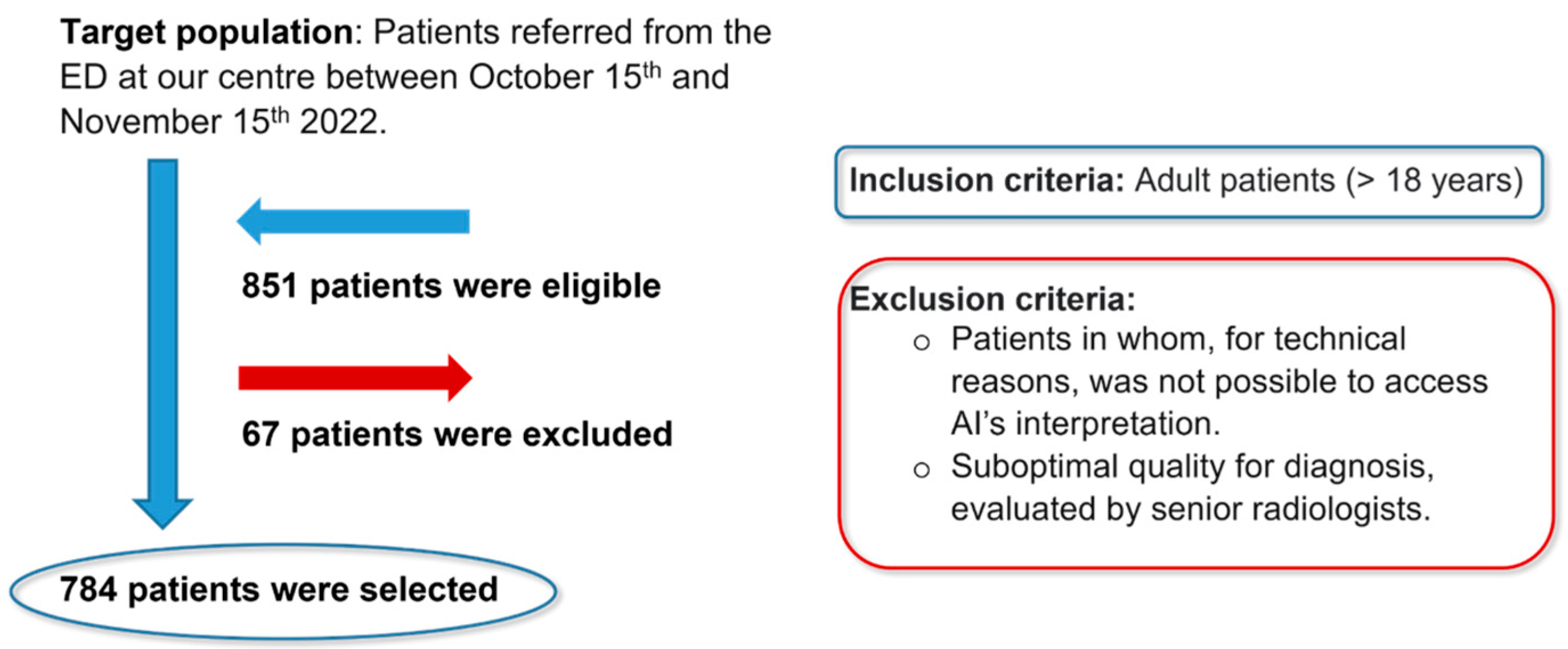
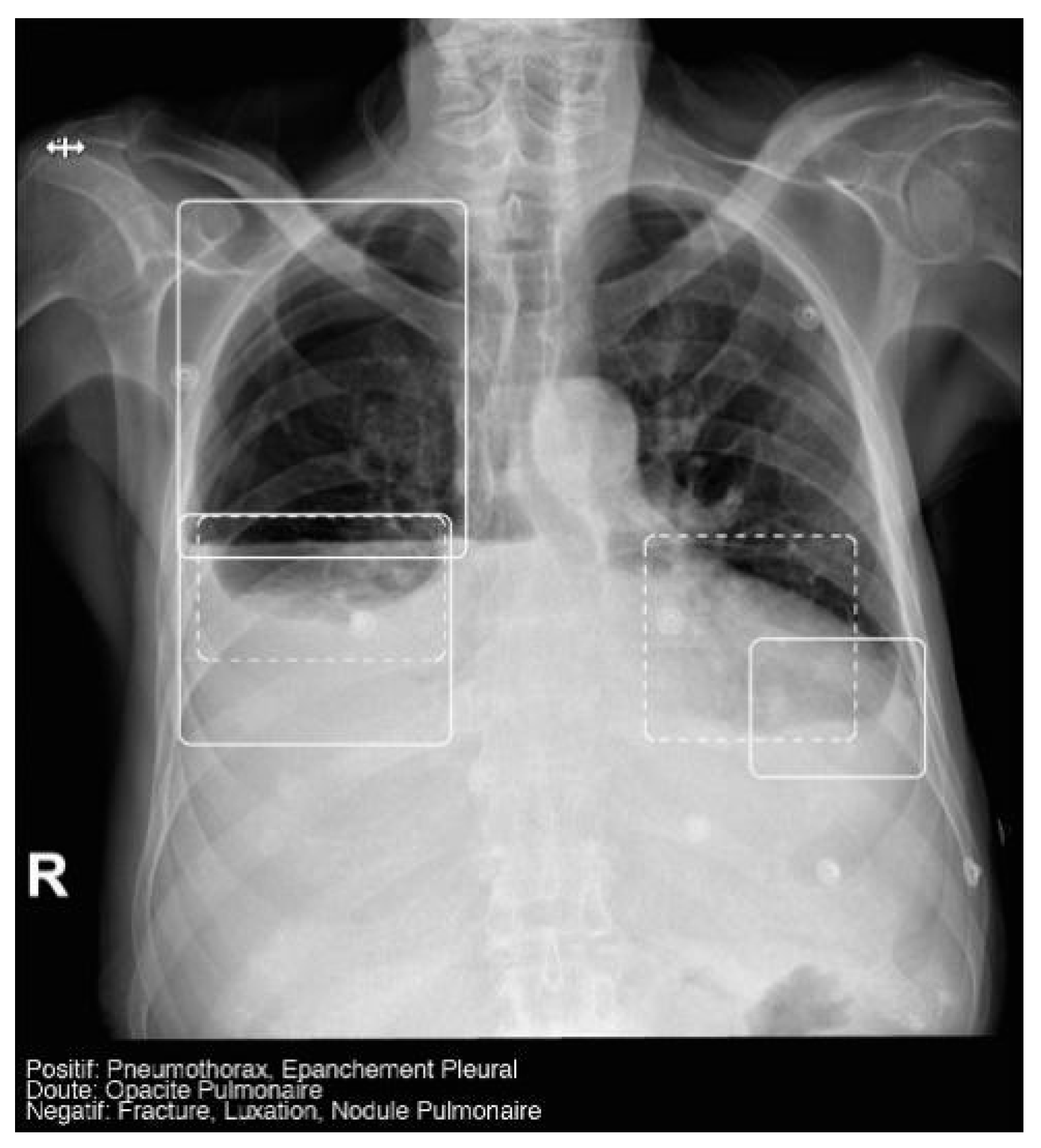

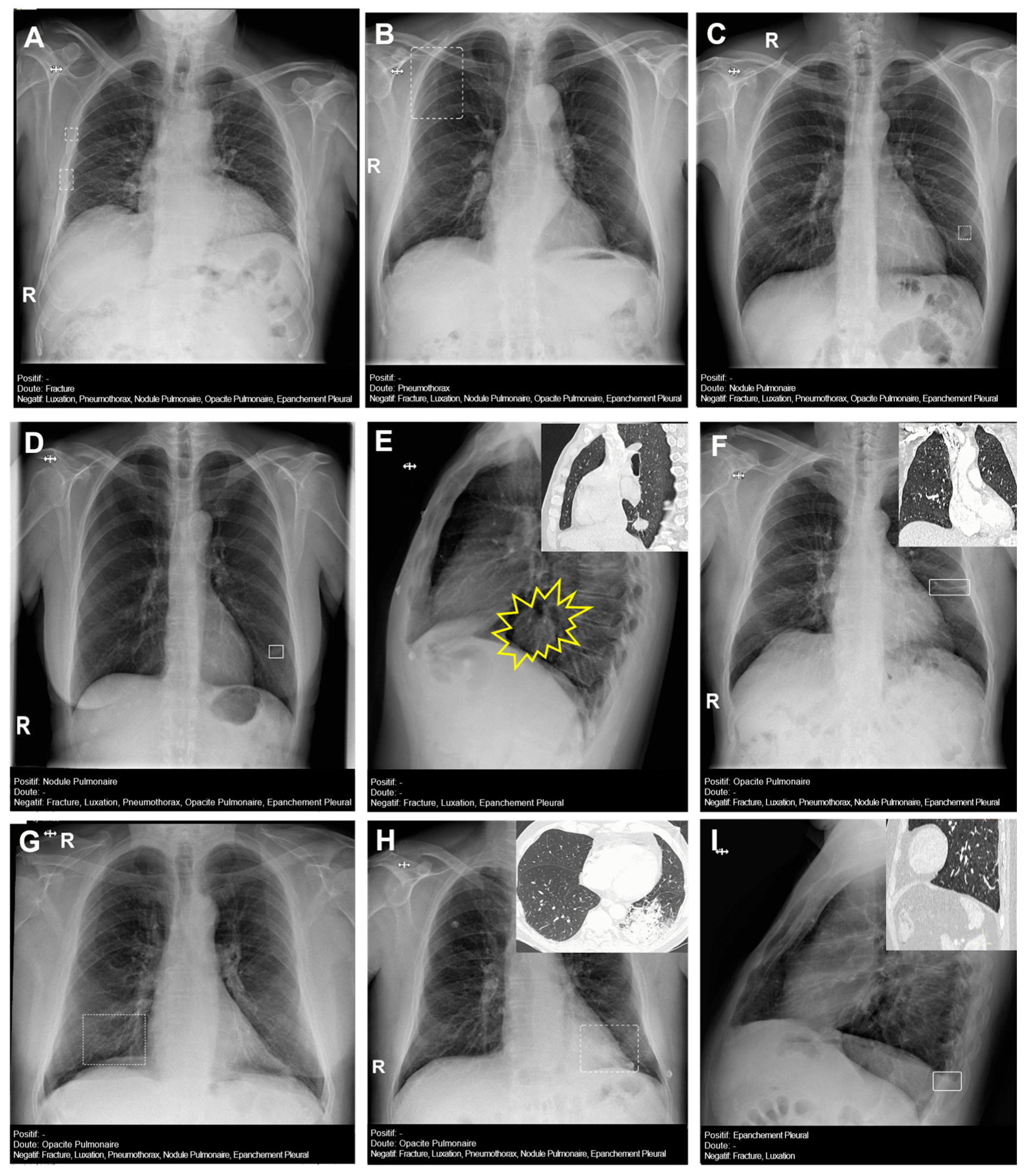
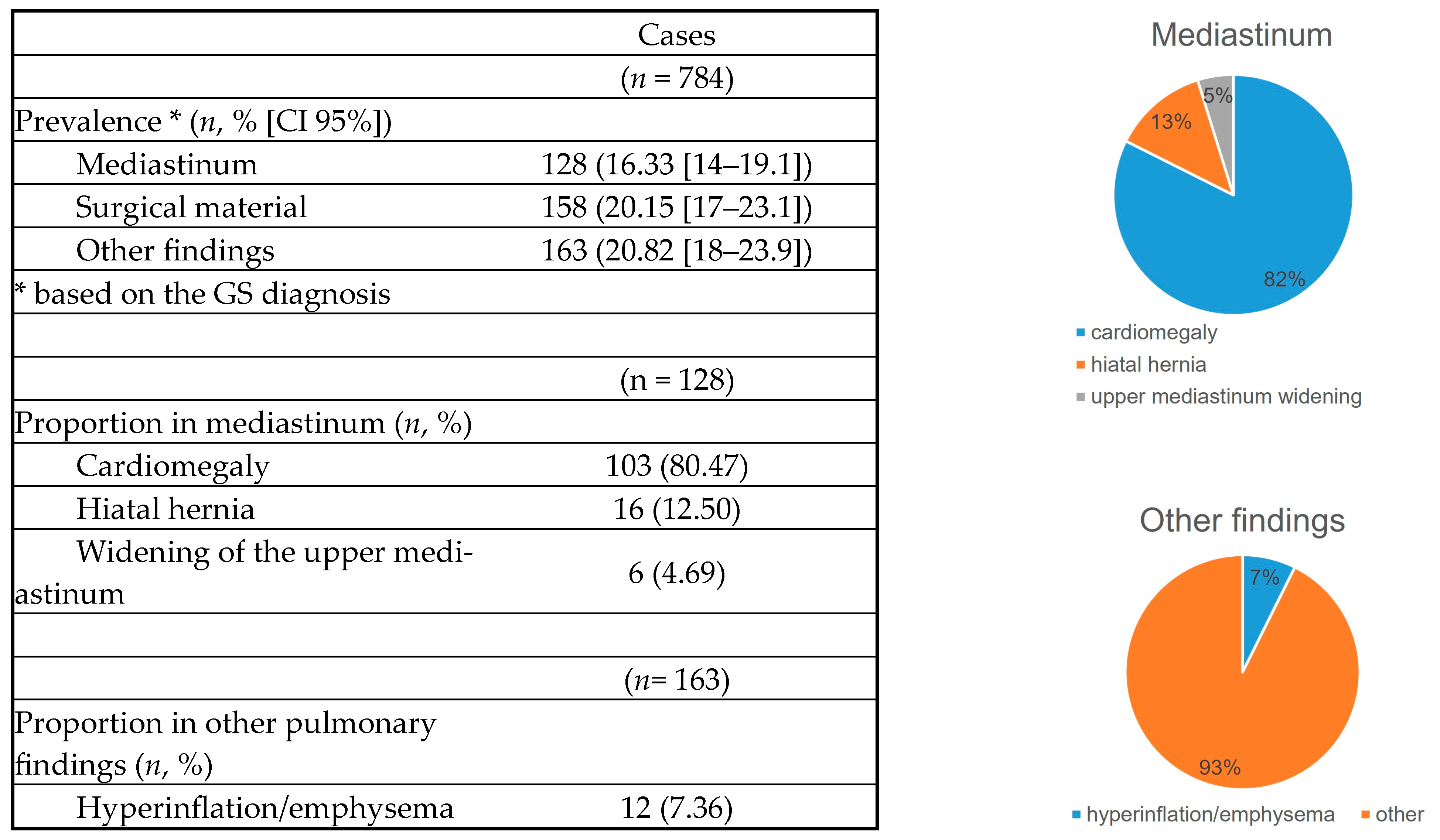
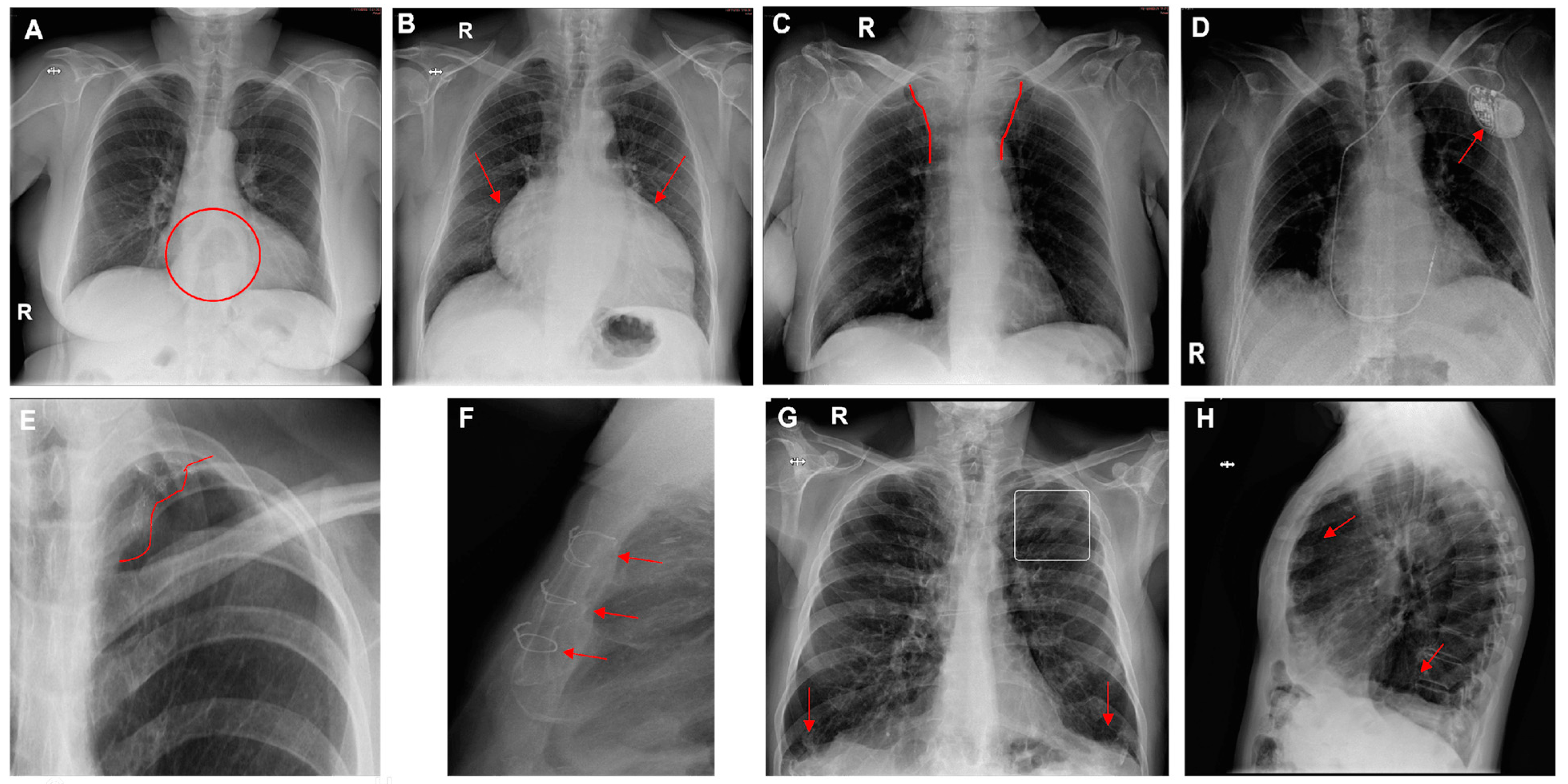
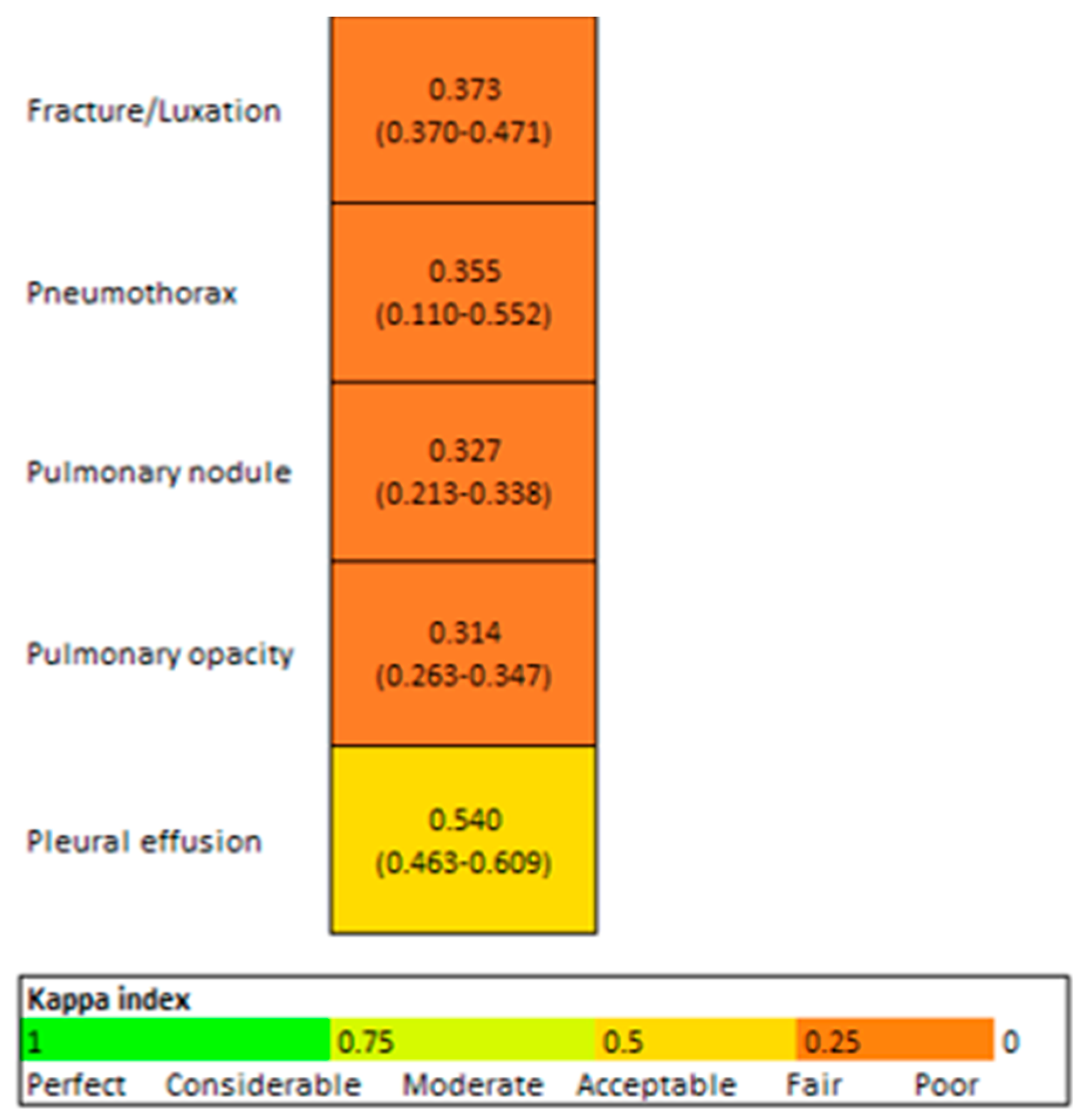
| Cases | ||
|---|---|---|
| (n = 784) | ||
| Patient’s age median [Q1; Q3] | 58 [44–74] | |
| Patient’s sex (n, %) | ||
| Man | 378 (48.21) | |
| Woman | 406 (51.79) | |
| Number of projections (n, %) | ||
| 1 | 109 (13.9) | |
| 2 | 675 (86.10) | |
| X-ray quality (n, %) | ||
| Optimal | 707 (90.18) | |
| Fair | 77 (9.82) |
| Cases | |
|---|---|
| (n = 784) | |
| Prevalence * (n, % [CI 95%]) | |
| Fracture/Luxation | 10 (1.28 [0.61–2.33]) |
| Pneumothorax | 3 (0.38 [0.079–1.1]) |
| Pulmonary nodule | 20 (2.55 [1.6–3.93]) |
| Pulmonary opacity | 112 (14.29 [11–16.2]) |
| Pleural effusion | 71 (9.06 [7.1–11.3]) |
| Mediastinum | 128 (16.33 [14–19.1]) |
| Surgical material | 158 (20.15 [17–23.1]) |
| Other findings | 163 (20.82 [18–23.9]) |
| Overall Cases | |||
|---|---|---|---|
| (n = 784) | |||
| Resident’s Diagnostic Performance | AI’s Diagnostic Performance | ||
| Fracture (doubtful diagnoses/certain ratio) | 0/784 | 19/765 | |
| Doubtful diagnoses/% positive ratio | DA | 19/15.79 | |
| Sensitivity (%, 95% CI) | 100 (69.2–100) | 100 (59–100) | |
| Specificity (%, 95% CI) | 99.9 (99.3–100) | 98.7 (97.6–99.4) | |
| PPV (%, 95% CI) | 90.9 (58.7–99.8) | 41.2 (18.4–67.1) | |
| NPV (%, 95% CI) | 100 (99.5–100) | 100 (99.5–100) | |
| AUC (95% CI) | 0.999 (0.998–1) | 0.993 (0.989–0.997) | |
| Pneumothorax (doubtful diagnoses/certain ratio) | 0/784 | 9/775 | |
| Doubtful diagnoses/% positive ratio | DA | 9/11.11 | |
| Sensitivity (%, 95% CI) | 100 (29–100) | 100 (15.8–100) | |
| Specificity (%, 95% CI) | 100 (99.5–100) | 100 (99.5–100) | |
| PPV (%, 95% CI) | 100 (29.2–100) | 100 (15.8–100) | |
| NPV (%, 95% CI) | 100 (99.5–100) | 100 (99.5–100) | |
| AUC (95% CI) | 1 (1–1) | 1 (1–1) | |
| Pulmonary nodule (doubtful diagnoses/certain ratio) | 4/780 | 16/768 | |
| Doubtful diagnoses/% positive ratio | 4/0 | 16/50 | |
| Sensitivity (%, 95% CI) | 75 (50.9–91.3) | 33.3 (9.92–65.1) | |
| Specificity (%, 95% CI) | 99.3 (98.5–99.8) | 99.6 (98.8–99.9) | |
| PPV (%, 95% CI) | 75 (50.9–91.3) | 57.1 (18.4–90.1) | |
| NPV (%, 95% CI) | 99.3 (98.5–99.8) | 98.9 (97.6–99.5) | |
| AUC (95% CI) | 0.872 (0.774–0.969) | 0.665 (0.525–0.804) | |
| Pulmonary opacity (doubtful diagnoses/certain ratio) | 16/768 | 170/614 | |
| Doubtful diagnoses/% positive ratio | 16/50 | 170/17.65 | |
| Sensitivity (%, 95% CI) | 71.2 (61.4–79.6) | 75.6 (64.9–84.4) | |
| Specificity (%, 95% CI) | 99.1 (98–99.7) | 95.3 (93.1–96.6) | |
| PPV (%, 95% CI) | 92.5 (84.4–97.2) | 71.3 (60.6–80.5) | |
| NPV (%, 95% CI) | 95.6 (93.8–97) | 96.2 (94.2–97.7) | |
| AUC (95% CI) | 0.851 (0.807–0.895) | 0.855 (0.807–0.902) | |
| Pleural effusion (doubtful diagnoses/certain ratio) | 12/772 | 21/763 | |
| Doubtful diagnoses/% positive ratio | 12/8.33 | 21/42.86 | |
| Sensitivity (%, 95% CI) | 67.1 (54.6–77.9) | 59.7 (46.4–71.9) | |
| Specificity (%, 95% CI) | 97.4 (96–98.5) | 98.9 (97.8–99.5) | |
| PPV (%, 95% CI) | 72.3 (59.8–82.7) | 82.2 (67.9–92) | |
| NPV (%, 95% CI) | 96.7 (95.2–97.9) | 96.5 (94.9–97.7) | |
| AUC (95% CI) | 0.823 (0.767–0.879) | 0.793 (0.731–0.854) | |
Disclaimer/Publisher’s Note: The statements, opinions and data contained in all publications are solely those of the individual author(s) and contributor(s) and not of MDPI and/or the editor(s). MDPI and/or the editor(s) disclaim responsibility for any injury to people or property resulting from any ideas, methods, instructions or products referred to in the content. |
© 2024 by the authors. Licensee MDPI, Basel, Switzerland. This article is an open access article distributed under the terms and conditions of the Creative Commons Attribution (CC BY) license (https://creativecommons.org/licenses/by/4.0/).
Share and Cite
López Alcolea, J.; Fernández Alfonso, A.; Cano Alonso, R.; Álvarez Vázquez, A.; Díaz Moreno, A.; García Castellanos, D.; Sanabria Greciano, L.; Hayoun, C.; Recio Rodríguez, M.; Andreu Vázquez, C.; et al. Diagnostic Performance of Artificial Intelligence in Chest Radiographs Referred from the Emergency Department. Diagnostics 2024, 14, 2592. https://doi.org/10.3390/diagnostics14222592
López Alcolea J, Fernández Alfonso A, Cano Alonso R, Álvarez Vázquez A, Díaz Moreno A, García Castellanos D, Sanabria Greciano L, Hayoun C, Recio Rodríguez M, Andreu Vázquez C, et al. Diagnostic Performance of Artificial Intelligence in Chest Radiographs Referred from the Emergency Department. Diagnostics. 2024; 14(22):2592. https://doi.org/10.3390/diagnostics14222592
Chicago/Turabian StyleLópez Alcolea, Julia, Ana Fernández Alfonso, Raquel Cano Alonso, Ana Álvarez Vázquez, Alejandro Díaz Moreno, David García Castellanos, Lucía Sanabria Greciano, Chawar Hayoun, Manuel Recio Rodríguez, Cristina Andreu Vázquez, and et al. 2024. "Diagnostic Performance of Artificial Intelligence in Chest Radiographs Referred from the Emergency Department" Diagnostics 14, no. 22: 2592. https://doi.org/10.3390/diagnostics14222592
APA StyleLópez Alcolea, J., Fernández Alfonso, A., Cano Alonso, R., Álvarez Vázquez, A., Díaz Moreno, A., García Castellanos, D., Sanabria Greciano, L., Hayoun, C., Recio Rodríguez, M., Andreu Vázquez, C., Thuissard Vasallo, I. J., & Martínez de Vega, V. (2024). Diagnostic Performance of Artificial Intelligence in Chest Radiographs Referred from the Emergency Department. Diagnostics, 14(22), 2592. https://doi.org/10.3390/diagnostics14222592







